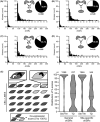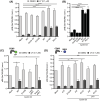CDK6 activity in a recurring convergent kinase network motif
- PMID: 36884374
- PMCID: PMC11977600
- DOI: 10.1096/fj.202201344R
CDK6 activity in a recurring convergent kinase network motif
Abstract
In humans, more than 500 kinases phosphorylate ~15% of all proteins in an emerging phosphorylation network. Convergent local interaction motifs, in which ≥two kinases phosphorylate the same substrate, underlie feedback loops and signal amplification events but have not been systematically analyzed. Here, we first report a network-wide computational analysis of convergent kinase-substrate relationships (cKSRs). In experimentally validated phosphorylation sites, we find that cKSRs are common and involve >80% of all human kinases and >24% of all substrates. We show that cKSRs occur over a wide range of stoichiometries, in many instances harnessing co-expressed kinases from family subgroups. We then experimentally demonstrate for the prototypical convergent CDK4/6 kinase pair how multiple inputs phosphorylate the tumor suppressor retinoblastoma protein (RB) and thereby hamper in situ analysis of the individual kinases. We hypothesize that overexpression of one kinase combined with a CDK4/6 inhibitor can dissect convergence. In breast cancer cells expressing high levels of CDK4, we confirm this hypothesis and develop a high-throughput compatible assay that quantifies genetically modified CDK6 variants and inhibitors. Collectively, our work reveals the occurrence, topology, and experimental dissection of convergent interactions toward a deeper understanding of kinase networks and functions.
Keywords: convergence; inhibitor; kinase; protein engineering; signaling network.
© 2023 The Authors. The FASEB Journal published by Wiley Periodicals LLC on behalf of Federation of American Societies for Experimental Biology.
Figures





References
Publication types
MeSH terms
Substances
LinkOut - more resources
Full Text Sources

